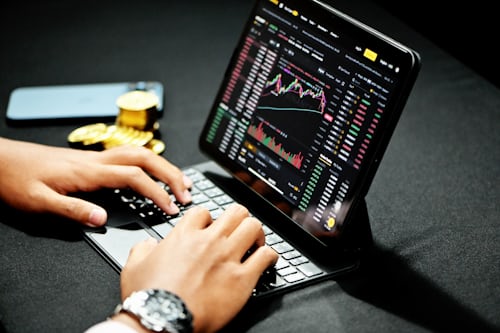Trading in foreign exchange takes place in a global market called the foreign exchange market, forex or simply FX. Here, as in other markets, all participants are connected in a kind of network and trade with each other continuously. Currencies can be traded either directly or indirectly in the form of derivatives such as CFDs, warrants, certificates, futures or options. However, there is no central exchange for currency trading, but it takes place between numerous players. In addition to private individuals and companies, these include financial institutions, central banks and even governments.
Basically, forex trading is about exchanging one currency for another at a certain exchange ratio, which is expressed in the exchange rate. Investors speculate on the change in exchange rates and in forex trading there are always two currencies being traded against each other. Although foreign exchange trading is not centrally organised, but takes place directly between market participants, there are central trading centres and networks, mainly located in London, New York and Zurich.
Figures from the Bank for International Settlements
The Bank for International Settlements (BIS), based in Basel, is considered the "central bank of central banks" and regularly collects data on what is happening in the foreign exchange market. According to the BIS, the total daily trading volume in April 2016 was the equivalent of almost USD 5.1 trillion.
The statistics above refer to the daily trading volume in April 2016, the last time the BIS published data was in April 2013. According to the BIS report, this was the first time since 2001 that the volume in April 2016 was below that of the previous reporting period.
A small note from trade-exness: "หาก (ส่วนใหญ่บนอินเทอร์เน็ต) มูลค่าการซื้อขายรายวันในตลาดแลกเปลี่ยนเงินตราต่างประเทศใน ฟอเร็กซ์ Exness ประเทศไทย มีการประเมินที่" ล้านล้าน "หลายนี่เป็นเพราะข้อผิดพลาดในการแปล"
"If (primarily on the internet) the daily turnover on the foreign exchange market is estimated at several "trillions", this is due to translation errors"
The BIS statement on market development: "Trading in foreign exchange (FX) markets averaged $5.1 trillion per day in April 2016, according to the 2016 Triennial Central Bank Survey of FX and over-the-counter (OTC) derivatives markets. This is down from $5.4 trillion in April 2013. FX spot trading declined for the first time since 2001, even as activity in FX derivatives continued to increase. Trading in OTC interest rate derivatives averaged $2.7 trillion per day in April 2016, up from $2.3 trillion in April 2013." The table below is taken from BIS statistics and lists the most traded currencies. The most important currencies ("forex majors") are USD, EUR, JPY, GBP, AUD, CAD and CHF.
Value of a currency in forex trading
The individual currencies of a pair always have a certain value ratio to each other. This ratio is subject to constant fluctuations. If you look at a currency pair, one currency is the base currency and the other is the reference currency. Both are set in relation to each other. The value of a currency depends on supply and demand. The more demand there is for a currency, the higher its value in the respective currency pair and vice versa.

